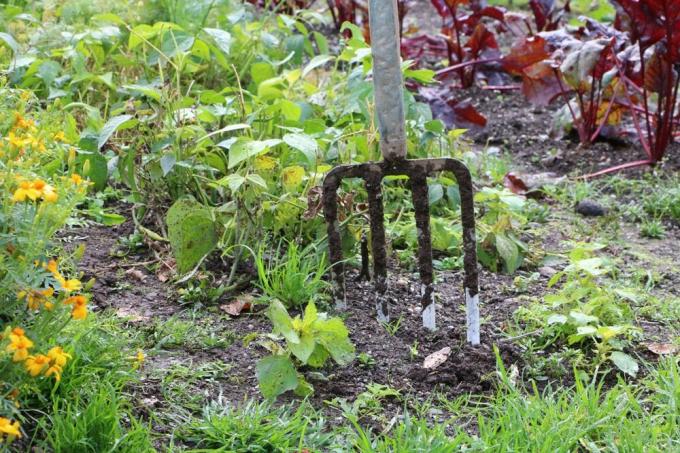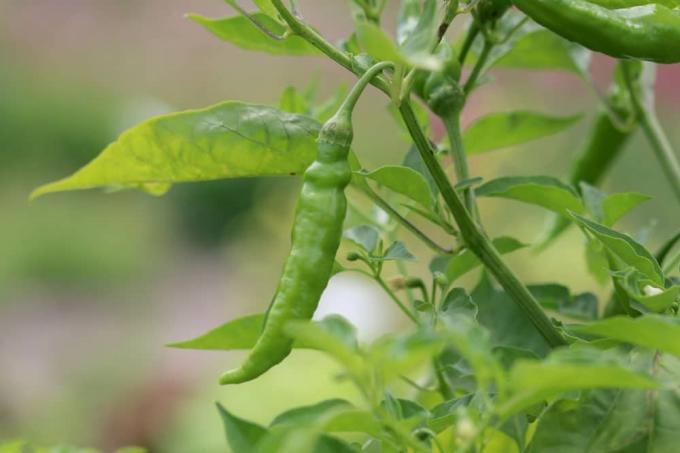
Table of contents
- Peat pots - definition
- seed trays
- sowing
- watering & fertilizing
- Plant
- Care mistakes, diseases or pests
- Conclusion
Planting your own vegetables in the garden bed and harvesting them later is not that difficult. The cultivation of the various vegetable plants is very easy in peat pots, which then later only have to be planted in the garden bed at the right time. There is a wide range and a large selection of seeds for the various types of vegetables in selected specialist shops. But you can also use your own seeds from last year's harvest, for example from tomato, pumpkin or pepper plants.
Peat pots - definition
Peat pots are available in well-stocked specialist shops, these are pots that only consist of natural ingredients, in this case pressed peat. They are filled with potting soil or potting soil into which the seeds are placed. Then the pots are placed together in larger seed trays. This way they can be poured without water leaking out. However, the pressed peat retains its shape even when wet. Peat pots are intended as a propagation aid for plants and have the following advantages over traditional plastic molded propagation pots:
- when the seedling is ready for planting, it does not need to be removed from the peat pot
- the pots are placed in the prepared planting hole
- the roots can find their way through the swollen peat walls
- the peat walls rot over time in the earth
- in this way it is ensured that the young seedling is not damaged during planting
- This also prevents what is known as plant shock, which many young plants suffer when they are planted
- the plant will grow faster and more vigorously in the new location because it does not lose its familiar environment
Tip:
If peat spring pots are used, then these are already mixed with plant substrate and commercially available in tablet form. The spring pots are softened in water and can be used immediately for sowing. These can also be planted later together with the seedling.
seed trays
Sowing takes place in the peat pots, which find their place in the seed trays. The growing bowls are flat planters that usually have a clear cover, the sufficient incidence of light and a constant moisture and heat inside the shell guaranteed. The increased humidity promotes seed germination. The seed trays can also be located indoors, for example on a windowsill. When growing vegetable plants in peat pots or peat pots in a seed tray, the following must be observed:
- Seed trays in the apartment must be covered, as the often dry room air could be harmful to the seeds
- with a location on a window sill, the hoods must be opened more often
- otherwise too much water will evaporate from the earth in strong sunlight
- condensation forms on the cover
- there is also a risk of heat build-up
- these two factors can promote fungal diseases
- a pen or similar object wedged between the cover and the edge of the shell improves the air circulation inside
- in late spring, when it is warm enough during the day, the seed trays are temporarily moved outside
- this has the advantage of hardening off the young seedlings
- the cover should be completely removed after some time when the young vegetable plants have gotten used to the new climate
Tip:
In the hardware store or garden center are growing trays in various sizes made of inexpensive plastic available. Some retailers already offer a combination of seed trays and peat pots.

sowing
Seeds lose their ability to germinate over time, so it makes more sense to use only fresh seeds. If you still have old seeds from the previous year, you can also check them for germination. To do this, the seeds are treated with pre-germination methods before being placed in the peat pots. Since there are different germs, for example cold germs or dark germs, these methods are also very different. If the seeds are fresh and ready to germinate, they go into the peat pots. The hobby gardener can choose between the simple peat pots or the peat pots. Both are equally suitable for cultivation and are later planted together with the young plant. Another advantage is offered to the hobby gardener. Because the vegetable plants sown in peat pots do not have to be pricked out or transplanted into larger pots. The young plants are given plenty of space in the peat pots to spread their roots, because they can penetrate the peat walls unhindered. When sowing, proceed as follows:
- Use a vegetable sowing calendar to determine which vegetables should be sown and when
- Filling peat pots with potting soil is not necessary with the peat spring pots
- use as many peat pots as vegetable plants are desired
- only one seed goes into each peat pot
- depending on whether they are light germs or others, the seeds must be inserted at different depths
- Place peat pots in seed trays
- then proceed as described under point "Cultivation trays".
Tip:
Since every vegetable has different requirements and demands on the sowing, everyone has to Vegetable garden owners in advance about the individual types of vegetables that should be grown in peat pots, also well informed.
watering & fertilizing
The peat pots with the seedlings must be kept moist without waterlogging. There is no need for fertilizers, since the potting soil filled into the peat pots already contains all the nutrients that the seeds need to germinate and sprout. Peat spring pots, on the other hand, already consist of a mixture of peat and potting soil, so that fertilization does not make sense here either.
Tip:
In order to avoid waterlogging in the seed trays, they can be provided with holes in the bottom through which excess water can drain. The seed trays are then placed on another tray, which can be regularly drained of excess water after watering.
Plant
When the seedlings have grown strong enough, they can be transplanted to their final location. You have to pay attention to the calendar, because not every vegetable is planted at the same time. The planting time is therefore very different for the various new vegetable plants. During the actual planting, the following must be observed:
- find a suitable location for the various vegetable plants
- Dig a sufficiently large planting hole, note the distance to the other plants
- Prepare soil with compost or vegetable fertilizer
- put new vegetable plant with the peat pot in the prepared hole
- so the delicate roots of the small plants are not damaged
- spread the prepared soil around the plant, press down lightly and water
Tip:
By growing in peat pots, the planting of many vegetable plants is quick and easy. In this way, the new plants can be quickly placed in the prepared planting holes, which saves a lot of time.
Care mistakes, diseases or pests
A lot can also go wrong when growing in peat pots. If the seedlings are kept too wet or too cold, they will not germinate and in the worst case no new vegetable plants will emerge. You also have to pay attention to the cover over the growing bowl, because condensation forms here or it is too warm overall under the cover, then fungal diseases can quickly develop, which will prevent germination and growth of young plants prevented. Another reason why the seeds don't germinate could also be old seeds that have lost their ability to germinate. Other diseases or even pests do not usually occur when growing vegetable plants.
Conclusion
If you don't want to damage your small new vegetable plants after they have been planted, use peat pots. Sowing takes place in the same way as in conventional seed pots, but the peat pots are planted in the new location together with the young seedlings. This protects the roots. Later the peat pots rot in the earth, the now longer and stronger roots of the vegetable plants find their way through the peat walls and can grow well. If you grow a lot of vegetable plants in this way, you save a lot of time when preparing for planting. Because pricking out the seedlings, intermediate repotting is no longer necessary and when planting, the entire pot is only removed from the seed tray and placed in the prepared planting hole.
 garden editorial
garden editorial I write about everything that interests me in my garden.
Learn more about maintaining a vegetable garden

Make a climbing aid for cucumbers yourself: building instructions
Cucumbers are healthy, tasty and versatile. In order for the cultivation in your own garden to be successful, you should offer the cucumber tendril, which likes to climb, optimal conditions. The easiest way to do this is with a cucumber trellis, which you can quickly and easily build yourself with our instructions.

Pricking out vegetables: Information for vegetable plants such as spinach, corn & Co
Many gardeners prefer their vegetables on the windowsill or in the greenhouse in the spring. After some time, the seedlings must be isolated by pricking out. This measure is essential for their survival so that they can develop healthily and vigorously.

Growing vegetables in the garden – which vegetables to plant next to each other?
Today, even a hobby gardener knows: With the right neighbors, vegetable plants develop particularly well in mixed cultures. You can even defend yourself against pests together. In this article we have put together for you which types of vegetables go well together and which go poorly together.

What is a mixed culture? Examples with table from the garden
Ornamental and crop plants of different species and genera form alliances to defend themselves against attacks by diseases and pests. Clever home gardeners take advantage of this strategy and cultivate their vegetables in mixed cultures. You can read here what exactly is behind this technical term. Field-tested examples from the garden clarify the connections.

Sowing calendar for vegetables - when to sow which vegetables?
With so many different types of vegetables, it is not easy to find the right time for sowing. Finally, the appointment differs depending on the species. In addition, of course, it also makes a difference whether the vegetables are pre-cultivated in the house, cold frame or greenhouse or sown straight into the field.

Growing pepperoni plants from seed - instructions to harvest
The cultivation of the crunchy peppers is extremely popular among many hobby gardeners. rightly so! - Because the colorful fruits of the pepperoni plants not only beautify the vegetable patch, but are also extremely tasty. If you also prefer rare or special types of pepper, you can prefer them yourself with a comparatively small amount of work.



